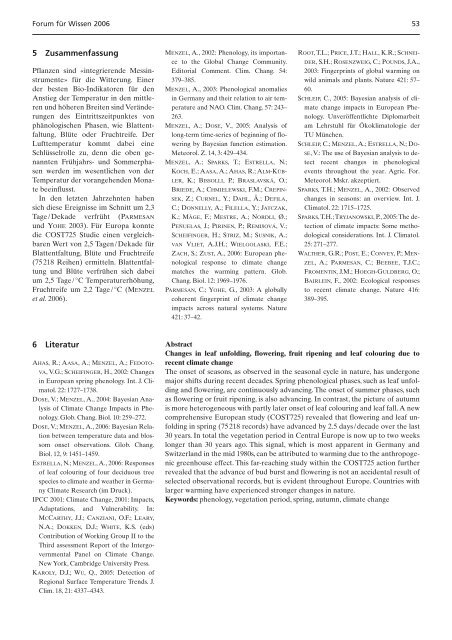Zeitliche Verschiebungen von Austrieb, Blüte, Fruchtreife und ...
Zeitliche Verschiebungen von Austrieb, Blüte, Fruchtreife und ...
Zeitliche Verschiebungen von Austrieb, Blüte, Fruchtreife und ...
Sie wollen auch ein ePaper? Erhöhen Sie die Reichweite Ihrer Titel.
YUMPU macht aus Druck-PDFs automatisch weboptimierte ePaper, die Google liebt.
Forum für Wissen 2006<br />
53<br />
5 Zusammenfassung<br />
Pflanzen sind «integrierende Messinstrumente»<br />
für die Witterung. Einer<br />
der besten Bio-Indikatoren für den<br />
Anstieg der Temperatur in den mittleren<br />
<strong>und</strong> höheren Breiten sind Veränderungen<br />
des Eintrittszeitpunktes <strong>von</strong><br />
phänologischen Phasen, wie Blattentfaltung,<br />
<strong>Blüte</strong> oder <strong>Fruchtreife</strong>. Der<br />
Lufttemperatur kommt dabei eine<br />
Schlüsselrolle zu, denn die oben genannten<br />
Frühjahrs- <strong>und</strong> Sommerphasen<br />
werden im wesentlichen <strong>von</strong> der<br />
Temperatur der vorangehenden Monate<br />
beeinflusst.<br />
In den letzten Jahrzehnten haben<br />
sich diese Ereignisse im Schnitt um 2,3<br />
Tage /Dekade verfrüht (PARMESAN<br />
<strong>und</strong> YOHE 2003). Für Europa konnte<br />
die COST725 Studie einen vergleichbaren<br />
Wert <strong>von</strong> 2,5 Tagen /Dekade für<br />
Blattentfaltung, <strong>Blüte</strong> <strong>und</strong> <strong>Fruchtreife</strong><br />
(75 218 Reihen) ermitteln. Blattentfaltung<br />
<strong>und</strong> <strong>Blüte</strong> verfrühen sich dabei<br />
um 2,5 Tage /°C Temperaturerhöhung,<br />
<strong>Fruchtreife</strong> um 2,2 Tage /°C (MENZEL<br />
et al. 2006).<br />
MENZEL, A., 2002: Phenology, its importance<br />
to the Global Change Community.<br />
Editorial Comment. Clim. Chang. 54:<br />
379–385.<br />
MENZEL, A., 2003: Phenological anomalies<br />
in Germany and their relation to air temperature<br />
and NAO. Clim. Chang. 57: 243–<br />
263.<br />
MENZEL, A.; DOSE, V., 2005: Analysis of<br />
long-term time-series of beginning of flowering<br />
by Bayesian function estimation.<br />
Meteorol. Z. 14, 3: 429–434.<br />
MENZEL, A.; SPARKS, T.; ESTRELLA, N.;<br />
KOCH, E.; AASA, A.; AHAS, R.; ALM-KÜB-<br />
LER, K.; BISSOLLI, P.; BRASLAVSKÁ, O.;<br />
BRIEDE, A.; CHMIELEWSKI, F.M.; CREPIN-<br />
SEK, Z.; CURNEL, Y.; DAHL, Å.; DEFILA,<br />
C.; DONNELLY, A.; FILELLA, Y.; JATCZAK,<br />
K.; MÅGE, F.; MESTRE, A.; NORDLI, Ø.;<br />
PEÑUELAS, J.; PIRINEN, P.; REMISOVÁ, V.;<br />
SCHEIFINGER, H.; STRIZ, M.; SUSNIK, A.;<br />
VAN VLIET, A.J.H.; WIELGOLASKI, F.E.;<br />
ZACH, S.; ZUST, A., 2006: European phenological<br />
response to climate change<br />
matches the warming pattern. Glob.<br />
Chang. Biol. 12: 1969–1976.<br />
PARMESAN, C.; YOHE, G., 2003: A globally<br />
coherent fingerprint of climate change<br />
impacts across natural systems. Nature<br />
421: 37–42.<br />
ROOT, T.L.; PRICE, J.T.; HALL, K.R.; SCHNEI-<br />
DER, S.H.; ROSENZWEIG, C.; POUNDS, J.A.,<br />
2003: Fingerprints of global warming on<br />
wild animals and plants. Nature 421: 57–<br />
60.<br />
SCHLEIP, C., 2005: Bayesian analysis of climate<br />
change impacts in European Phenology.<br />
Unveröffentlichte Diplomarbeit<br />
am Lehrstuhl für Ökoklimatologie der<br />
TU München.<br />
SCHLEIP, C.; MENZEL, A.; ESTRELLA, N.; DO-<br />
SE, V.: The use of Bayesian analysis to detect<br />
recent changes in phenological<br />
events throughout the year. Agric. For.<br />
Meteorol. Mskr. akzeptiert.<br />
SPARKS, T.H.; MENZEL, A., 2002: Observed<br />
changes in seasons: an overview. Int. J.<br />
Climatol. 22: 1715–1725.<br />
SPARKS,T.H.;TRYJANOWSKI, P., 2005:The detection<br />
of climate impacts: Some methodological<br />
considerations. Int. J. Climatol.<br />
25: 271–277.<br />
WALTHER, G.R.; POST, E.; CONVEY, P.; MEN-<br />
ZEL, A.; PARMESAN, C.; BEEBEE, T.J.C.;<br />
FROMENTIN, J.M.; HOEGH-GULDBERG,O.;<br />
BAIRLEIN, F., 2002: Ecological responses<br />
to recent climate change. Nature 416:<br />
389–395.<br />
6 Literatur<br />
AHAS, R.; AASA, A.; MENZEL, A.; FEDOTO-<br />
VA, V.G.; SCHEIFINGER, H., 2002: Changes<br />
in European spring phenology. Int. J. Climatol.<br />
22: 1727–1738.<br />
DOSE, V.; MENZEL, A., 2004: Bayesian Analysis<br />
of Climate Change Impacts in Phenology.<br />
Glob. Chang. Biol. 10: 259–272.<br />
DOSE, V.; MENZEL, A., 2006: Bayesian Relation<br />
between temperature data and blossom<br />
onset observations. Glob. Chang.<br />
Biol. 12, 9: 1451–1459.<br />
ESTRELLA, N.; MENZEL, A., 2006: Responses<br />
of leaf colouring of four deciduous tree<br />
species to climate and weather in Germany<br />
Climate Research (im Druck).<br />
IPCC 2001: Climate Change, 2001: Impacts,<br />
Adaptations, and Vulnerability. In:<br />
MCCARTHY, J.J.; CANZIANI, O.F.; LEARY,<br />
N.A.; DOKKEN, D.J.; WHITE, K.S. (eds)<br />
Contribution of Working Group II to the<br />
Third assessment Report of the Intergovernmental<br />
Panel on Climate Change.<br />
New York, Cambridge University Press.<br />
KAROLY, D.J.; WU, Q., 2005: Detection of<br />
Regional Surface Temperature Trends. J.<br />
Clim. 18, 21: 4337–4343.<br />
Abstract<br />
Changes in leaf unfolding, flowering, fruit ripening and leaf colouring due to<br />
recent climate change<br />
The onset of seasons, as observed in the seasonal cycle in nature, has <strong>und</strong>ergone<br />
major shifts during recent decades. Spring phenological phases, such as leaf unfolding<br />
and flowering, are continuously advancing. The onset of summer phases, such<br />
as flowering or fruit ripening, is also advancing. In contrast, the picture of autumn<br />
is more heterogeneous with partly later onset of leaf colouring and leaf fall.A new<br />
comprehensive European study (COST725) revealed that flowering and leaf unfolding<br />
in spring (75 218 records) have advanced by 2.5 days /decade over the last<br />
30 years. In total the vegetation period in Central Europe is now up to two weeks<br />
longer than 30 years ago. This signal, which is most apparent in Germany and<br />
Switzerland in the mid 1980s, can be attributed to warming due to the anthropogenic<br />
greenhouse effect. This far-reaching study within the COST725 action further<br />
revealed that the advance of bud burst and flowering is not an accidental result of<br />
selected observational records, but is evident throughout Europe. Countries with<br />
larger warming have experienced stronger changes in nature.<br />
Keywords: phenology, vegetation period, spring, autumn, climate change





